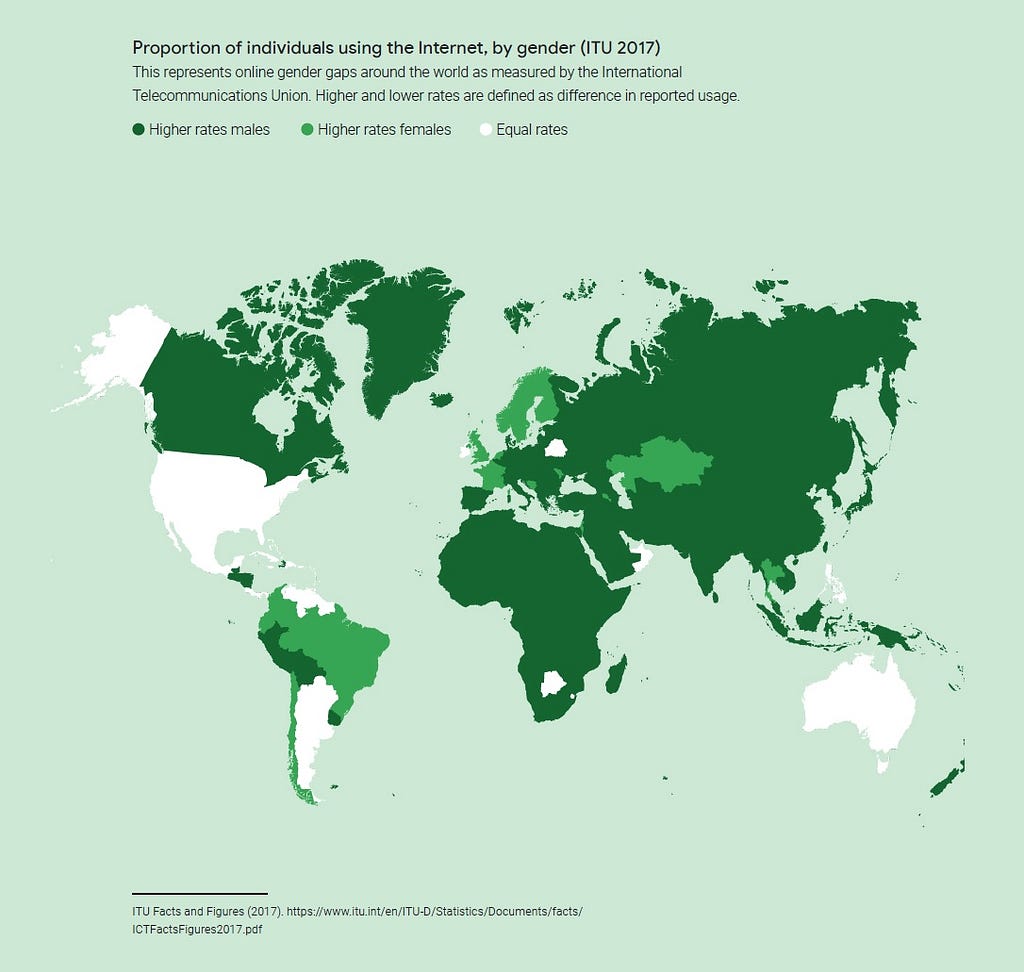Latest news about Bitcoin and all cryptocurrencies. Your daily crypto news habit.
 (Image credits: Google)
(Image credits: Google)
A new report published recently by Google reaffirms quite clearly that “The internet isn’t gender equitable.”
“For nearly 2 years, we conducted research with 4,000 people across the gender spectrum in 7 countries to understand why and what tech makers can do about it,” writes research lead Nithya Sambasivan on Twitter, referring to their research activity in Bangladesh, Indonesia, Mexico, Nigeria, Pakistan, Brazil, and India.
body[data-twttr-rendered="true"] {background-color: transparent;}.twitter-tweet {margin: auto !important;}
The Internet isn't gender equitable. For nearly 2 years, we conducted research with 4,000 people across the gender spectrum in 7 countries to understand why and what tech makers can do about it. We're launching our research report today: https://t.co/D6b38zvSlK
According to the tech giant and statistics compiled by the International Telecommunication Union (ITU), estimates show there are fewer women online than men in two-thirds of countries worldwide.
In addition, ITU found that there is a strong link between gender parity in the enrollment ratio in tertiary education and gender parity in Internet use. The only region where a higher percentage of women than men are using the Internet is the Americas, where countries also score highly on gender parity in tertiary education.
While the report is written for technology makers, the author highlighted how important it is “that everyone advocates for gender equity as a baseline.”
“Unless we take an intentional approach, equity is not a default outcome of the Internet,” the study states. “Let us consider the impact of our technologies on women, from product inception to launch. We have an enormous opportunity to create more inclusive online experiences for all of the Internet’s citizens, because technology works best when it works for everyone.”
Google identifies four main roadblocks to gender equity online:
- ACCESS: “Many women in our research have limited agency, mobility, and time to access the Internet. The Internet is sometimes perceived as a threat to women’s roles and reputations. Accessing the Internet in low-connectivity regions often requires travel, but physical mobility can be constrained for women. Women with significant domestic responsibilities say they have little free time to spend online.”
- CONTENT AND COMMUNITY: “The Internet is full of content and communities — blogs, videos, social media conversations, and more. But women often struggle to find relevant content or supportive communities online. The expectation of harassment and misogyny leads to less content creation by women. And even when content does exist, it can be hard to find because recommendation algorithms are often trained on male-majority data.”
- PRIVACY: Organizations commonly think of privacy as the management of online identity. Women often share their devices with friends and family and need to create privacy practices that allow them to share those devices comfortably. For example, women use app locks or delete their search history. And while many online experiences require personal information like name and phone number, women are often uncomfortable disclosing this information.
- SAFETY: “New technologies can improve the lives of women by giving them the tools they need to stay connected. But these tools can also create safety concerns. Women frequently experience online abuse like cyberstalking, impersonation, and personal content leaks. Consequences of online abuse can be severe, leading to real-world repercussions like reputation damage and physical violence. Physical harassment is a significant problem, especially in public spaces. Women rarely report abuse to online platforms or authorities. Instead they limit participation online and turn to family members for support.”
In their conclusion, the researchers also encourage technology leaders to acknowledge a few truths:
- People who identify as women and non-binary people regularly navigate double standards and prejudices, and the Internet far too often produces and reinforces these injustices.
- The Internet provides the tools necessary to challenge age-old discrimination, and leaders can use the rapid speed of technological evolution as a positive force for accelerating equity.
- Online equity can increase participation and justice, but not alone.
So how do we move forward and achieve gender equity online?
Google offers four ways to frame the case for organizations to embrace and move toward gender equity online:
- The ethical case: Ethically speaking, organizations have an obligation to build an Internet that benefits everyone
- The recruiting case: Powerful and meaningful work attracts the best talent.
- The business case: Inclusive design can enable product growth, benefitting the business.
- The technical case: Addressing gender equity fosters technical innovation.
Back in November 2018, The Web Foundation’s For The Web report noticed how “the growth of Internet users over the past 30 years has been nothing short of remarkable.” It also warned that “closing the global digital divide will remain an impossible goal if we don’t take steps to close the digital gender gap.”
“Just 13 years ago, in 2005, not even 16% of the global population was online, and the internet was predominately Western — nearly 50% of Europeans were online at that time, compared to just 2% of Africans,” the report stated. “While we’ve made great strides in the years since — with nearly 50% of the world estimated to be using the internet today — we still have a long way to go.”
Globally, the digital divide — the division between those who are able to access and use the internet and those who are not — falls primarily along gender, economic, and geographic lines. Most of the nearly 4 billion people offline today are women — research has shown that women in poor, urban areas are up to 50% less likely to be online than men in the same communities. Most of those offline live in low- and middle-income countries. The percentage of Europeans online today (80%) is nearly four times that of Africans (22%).
According to the Web Foundation, the consequences of the exclusion from access to the Internet are “significant,” as “to be offline today is to miss out on economic opportunity, global public debate, social and cultural exchange, basic government services, and democratic empowerment.”
The report adds that “failing to connect these offline populations will result in a loss for everyone: the longer these billions remain unconnected, the less we will all benefit from their collective knowledge, talent and contributions to economic prosperity.”
In March 2018, a study commissioned by the European Parliament’s Policy Department for Citizens’ Rights and Constitutional Affairs at the request of the FEMM Committee attempted to reveal the links between the different factors — access, skills, socio-economic and cultural — , which prevent women from having equal access to digital technology. It also explored ways of dealing with online and offline inequalities to the effect of closing the digital gender gap and improving women’s and girls’ digital inclusion and future technology-related career paths.
The study, which cites Eurostat data, revealed that, although the digital divide in Europe is narrowing, it is still an issue. In 2013, 70% of women aged 16–74 had Internet access at home compared to 74% of men; at work, the percentages were 29% and 35% respectively. In terms of regular Internet use, in 2013, weekly or more frequent use of the Internet (including every day) was 69% for women compared to 74% of men; 59% of women age 16–74 were using the Internet every day (65% of men). Still, between 2010 and 2014 the percentage of women aged 16–74 frequently using the Internet increased by 13 % (compared with a 9% increase among men).
In 2018, the Organization for Economic Co-operation and Development (OECD) also looked at the issue in its Bridging the Digital Gender Divide: Include, Upskill, Innovate, according to which “women are not currently empowered to take advantage of the opportunities offered by the digital transformation.”
Linking access to opportunities, the OECD showed how “while G20 economies have taken important actions to narrow gender gaps in general, more needs to be done to increase the participation of women and girls in the digital economy so that they too can contribute to and benefit from the digital transformation that is under way.”
The OECD study pointed out how “On average around the world, girls often attend fewer years of school than boys — which ultimately results in worldwide higher illiteracy rates for women than men; they also face higher hurdles than men when it comes to starting or owning an entrepreneurial endeavor, and they struggle to combine family duties with earning much needed household income.”
It noticed how disadvantages created from the digital divide create disparities not necessarily related to access and digital rights:
- Women and girls may benefit disproportionally from digital technologies.
- The Internet improves information flows and lowers hurdles to accessing both general and specific knowledge, including about education and training possibilities. While this is beneficial to all people, it may prove particularly helpful for girls with little education (if any), as they may be able to access online courses and acquire general information, also delivered in the form of podcasts, videos, tutorial and “how to” types of instructions that reduce the reliance on written text books.
- In the case of women depending on agriculture for their income, access to the Internet may allow them to benefit from weather forecasts and thus help optimize the harvesting time and the quality and quantity of output.
- It may also help women access health care-related information, including about specific medical treatments or prophylaxis, and reduce the risks and costs of early pregnancy.
The Internet is Not Gender Equitable was originally published in Hacker Noon on Medium, where people are continuing the conversation by highlighting and responding to this story.
Disclaimer
The views and opinions expressed in this article are solely those of the authors and do not reflect the views of Bitcoin Insider. Every investment and trading move involves risk - this is especially true for cryptocurrencies given their volatility. We strongly advise our readers to conduct their own research when making a decision.

